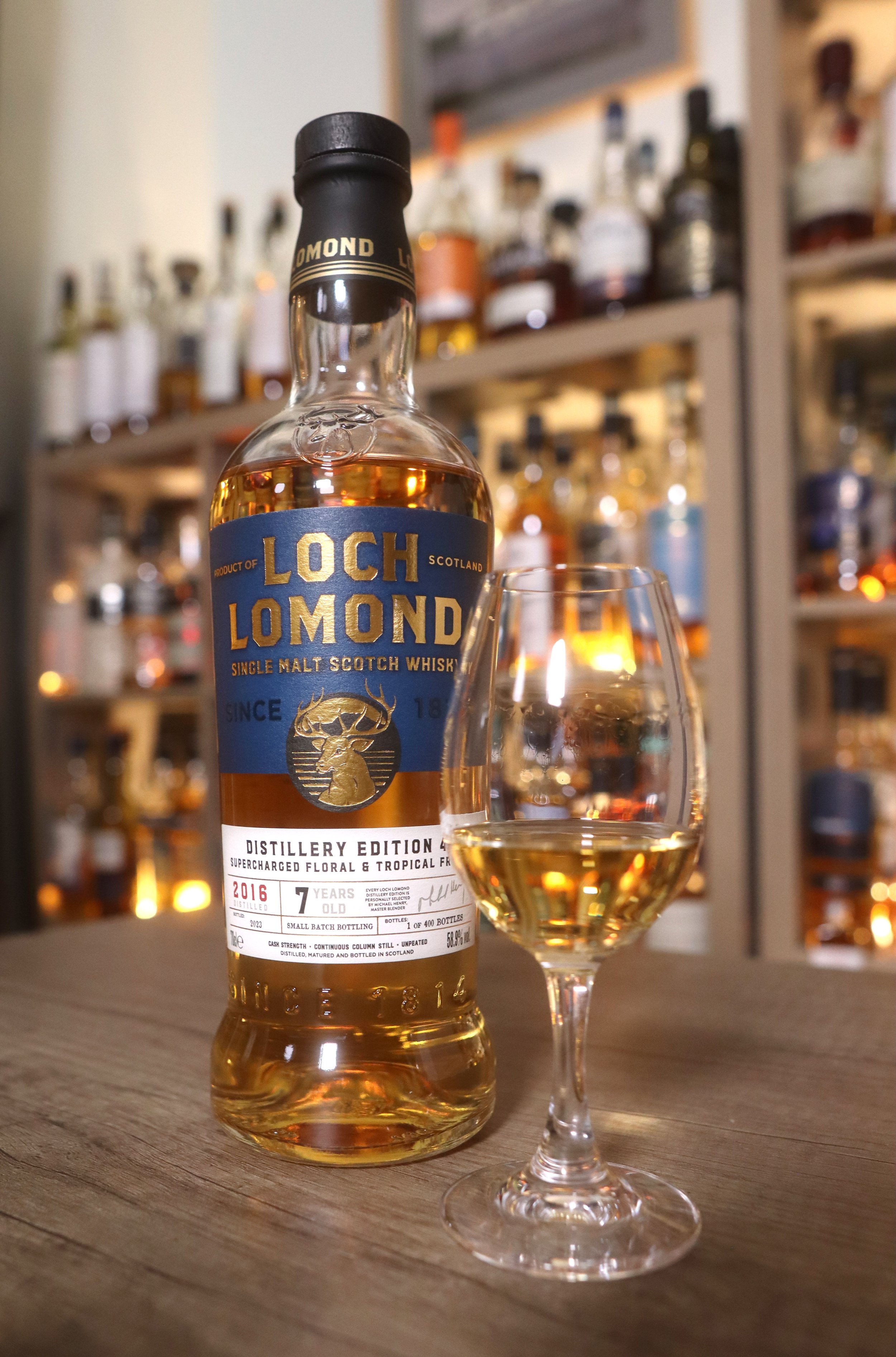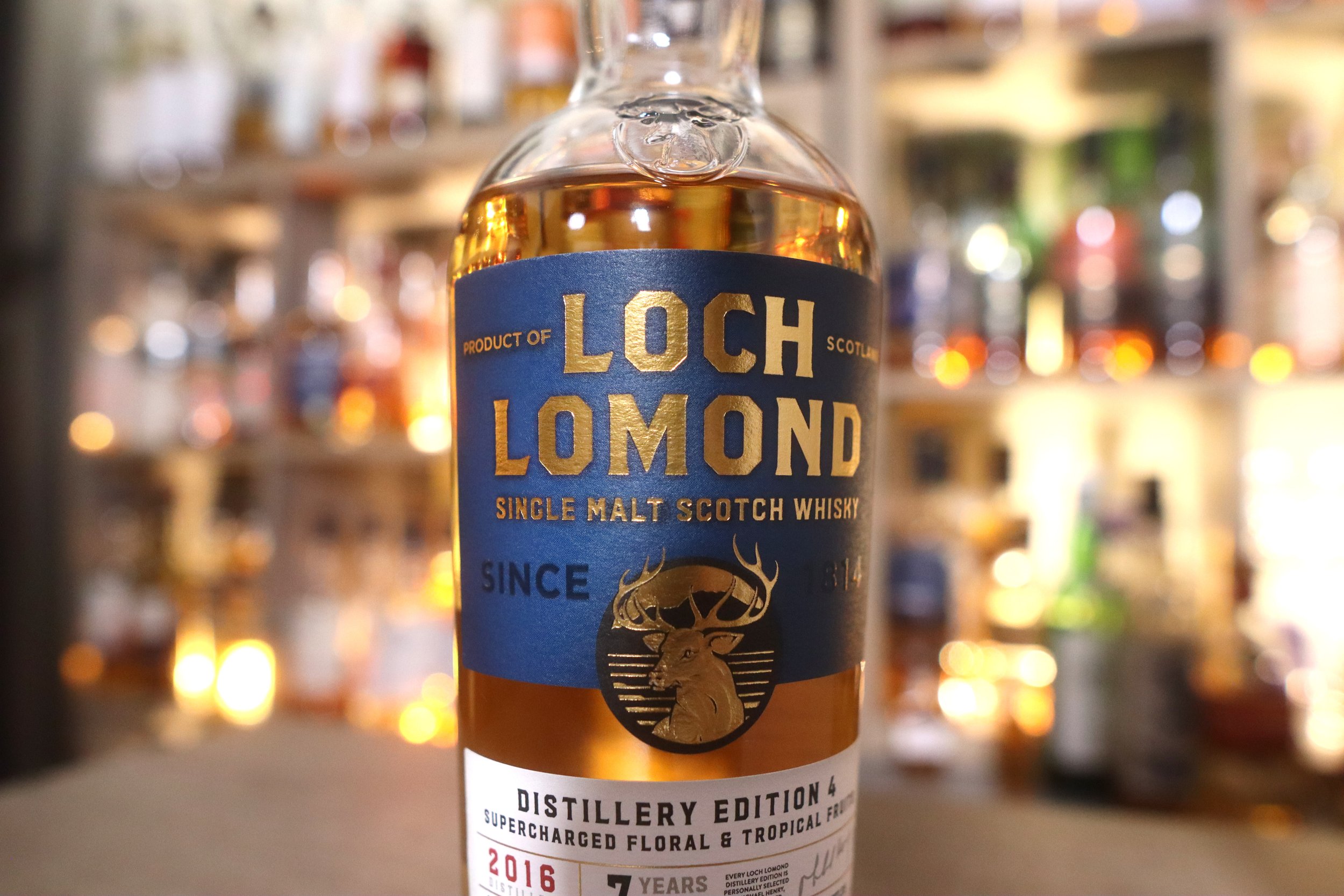Loch Lomond Distillery Edition 4
Official Limited Release | 58.9% ABV
Score: 7/10
Very Good Indeed.
TL;DR
Unique, fun, moreish, interesting and confusing
Deciphering Labels
Loch Lomond are good at playing with the categories. They don’t seem to mind that, regardless of how creative and differently they do things, they’re going to be stuck with a pretty bland and boring label; either Single Grain Scotch Whisky, or in the case of some other interesting ideas hiding behind some pretty simplistic nomenclature, Blended Scotch Whisky. In both cases, as they’re demonstrating with regularity these days, these could be a mix of almost anything.
They are tying us up in knots, leaving us to slowly take in the label as we try to unravel what’s inside; forcing us to consider and understand the categories of scotch and all the while challenging our loyalties to that kudos-laden strapline Single Malt.
But before we get to all of that, some broad brush framing. However, if you already know your malt from your grain in scotch, please feel free to skip this next bit. I'll meet you again after the gallery panel below. For those of you who care to, let’s have a look at what that single malt line actually means.
In the simplest of ways; in Scotland, malt whisky is made from 100% malted barley, by batch, in a pot still. Well, I suppose the batch thing is, in the case of a huge copper kettle pot still, incidental. Anyway, change either of those things; the grain type or the method of distillation, and you have Single Grain.
While we may imagine Single Grain whisky as that which is made at any of Scotland’s eight dedicated grain distilleries such as Strathclyde, North British or Invergordon, it’s not always the case. As examples, consider the 2023 release from Inchdairnie of their Ryelaw rye whisky or that of Bruichladdich’s Regeneration Project, both using grains other than malted barley and therefore labelled as Single Grain.
In both cases, and much to the confusion of many, the ‘Single’ element refers not to the grain used at all, rather it refers to the malt (or grain!) made at a single distillery - that single part is a single geographical location. Should you mix any of these ‘locations’ or grain types, you are then required to add the term ‘blended’.
So, mix two or more single malts, you have blended malt. Mix two or more single grains, you have blended grain. Mix both types of grain, you have blended scotch; even if both those grains come from the same distillery, such as in the case of Loch Lomond. There is no recognised Scotch category for a ‘Single Blend’. Even though they exist.
So, what exactly do we have here? For any of you that may be familiar with Loch Lomond’s Single Grain or Single Grain Peated releases, we are somewhere in that general ballpark. At the distillery in Alexandria they have a mighty and tall copper column still producing grain whisky, with a twist.
We need to note here that this is quite separate from their much larger grain distillery, this column is actually located in the same hall as their copper swan neck and straight neck pot stills. So what's that twist? Well, its primary purpose is to produce whisky in a column distillation from malted barley. Yes, that which is typically made in a pot still. Yes, as we’ve covered, it must be labelled Single Grain, but we now know what we’re dealing with is malt whisky, just not as we know it, or as the SWA regulations see it.
Now, the original inspiration or purpose of this still being installed at Loch Lomond is unknown to me. Efficiency? Experimentation? Innovation? Economies of scale? We may guess. I suppose a quick email to the ever generous Michael Henry may provide an answer, but I have a deadline for this write up and I suspect we pester the group’s Master Blender a bit often. It matters not, because what it makes today, amongst other things, we have an example of in the bottle in front of us.
Seven years ago, they ran malted barley wash through this copper column still that had been fermented with Lallemand distiller’s yeast. This, I’m told from a previous chat with MH, is to amp the floral, spicy character over the typically more fruity style from the more normally used M/MX distiller’s yeast. Then, to increase the body and flavour further, they take the spirit off the still at 80% as opposed to the usual 85% for malt-based grain. Clearly, actions specifically taken to enhance flavour and try something different.
You get the sense that, at every turn in the vast warehouses surrounding this distillery there are casks upon casks of experimental malts and grains just waiting to be readied for sharing and study. This, I feel, is the main drive, no; necessity of these special Distillery Edition releases - to allow us to participate in some of that sorcery and discovery.
Thus far in the series we’ve had a 9yo wine yeast release, a 5yo single distillery peated blend (labelled as Blended Scotch Whisky, see above) and most recently we enjoyed their XL Fermentation release. All of these are pure takes on the distillate and not one of them has spent any amount of focus or discussion around casks or maturation. Delightfully, you can compare and enjoy with very little cask impact to get in the way. Right up Wally Street. I note that we’ve not yet reviewed the DE1 wine yeast expression, but I hear there’s a Man in Skye on the case as we speak.
So, all of this is very geeky and interesting and fun and all, but what does it leave us with? Well, at the very least, a range of whiskies like no other. I mean that; there isn’t another official release from anywhere that is anything like these whiskies.
Is that good? Can we get it and can we afford it? Well, yes, but there’s a story there.
Review
Loch Lomond, single Grain Scotch Whisky, Distillery Edition 4, 400 bottles, 58.9% ABV
£45 exclusively direct from the distillery
If you’ve studied the photos and read the ramble from me, you may spot an unfortunate labelling error. Loch Lomond’s new branding (since 2022) utilises a ‘split’ front label where the lower section takes care of the intricate specs and description while the top section takes care of branding. It would seem, during bottling, the wrong top label was spooled and applied. It declares the liquid to be Single Malt Whisky and, as you now know, it is not. Loch Lomond removed the product from sale, but half of the stock had been sold before the mistake was discovered.
They have since emailed me (and I assume everyone) offering a replacement swap-out and a discount voucher for my trouble. Being typically impatient, I opened this upon arrival and so I won’t be returning it, but the £10 voucher is still mine. Spoiler: I’ll probably put that towards another bottle of the same if I’m honest.
They’ve suggested it’ll take a couple of weeks to put things right and get them back on the website after relabelling. I think it’ll be kinda fun to have two identical bottles side by side with different labels.
Although, to take £10 off what is already incredibly inexpensive cask strength whisky feels like I’d be rubbing salt into their wounds.
Score: 7/10
Very Good Indeed.
TL;DR
Unique, fun, moreish, interesting and confusing
Nose
Citrus pith, grapefruit and orange peel. Sherbet lemons, hairspray and atomised perfumes. White sugar mice, foam bananas and desiccated coconut. Lilies.
Palate
A bizarre arrival of creaminess and bitterness all at once. Sharp, piercing orange peel and a salty acidity too. Never has a whisky reminded me so much of a white wine; note to self - this’d be a killer accompaniment to seafood. It’s laced with some of the sweetness and confectionary notes from the nose, but it switches to and fro before settling on a medium-long bitter finish. It is very, very floral and perfumed with a little pickled ginger in the mix too.
It also hides it’s alcohol very well, no burn here despite the youth.
The Dregs
There’s a section in my whisky cabinet these days that I’m particularly drawn to. As I shuffle along the path from one new bottle to the next, I find my preferences being ever more refined, defined and dialled in. I’m after less glasses and less liquid. Less drinky, more thinky. And this is the style of whisky I want to spend my time thinking about. At this end of the cabinet there are a few bottles of Loch Lomond.
It’s really a brilliant time, generally, to be into whisky and enjoying the, honestly quite intimidating, variation we have available to us today. But there’s a trend; a shape to modern whisky and it needs to be kept in check, a little. There’s too much temptation to lean on that sweet, potent and heady oak cask to deliver flavour, spice, fruit and sweetness into scotch whisky. Rather than focusing on dialling flavour into the spirit in the first place, however you decide to do that, or allowing good old Father Time to do his work with far less active casks, there’s a prevalence to bottle far too much wood flavours into our whisky and it’s been happening for a long time. But you know what? It’s okay. It’s tasty, it sells whisky and it works. It has its place.
And yet, amongst the crazy choices we have available today, there’s very little of it with a focus on pure spirit, on refill casks and flavours not derived from wood. I think this may change, in time, but right now there’s a gap (looking at you Isle of Arran - how’s that 14yo coming along?).
I’m very happy that some distillers out there, Loch Lomond being one of them, are doing something different. Not everywhere - and not all of the time, but enough. Enough to offer things that are different, celebrating the spirit itself, new and remarkable enough to make each sip so communicative that, as we try to decipher the words on the outside, we can process what it all means with flavourful help from the liquid on the inside.
Score: 7/10
Tried this? Share your thoughts in the comments below. WMc
-
Dramface is free.
Its fierce independence and community-focused content is funded by that same community. We don’t do ads, sponsorships or paid-for content. If you like what we do you can support us by becoming a Dramface member for the price of a magazine.
However, if you’ve found a particular article valuable, you also have the option to make a direct donation to the writer, here: buy me a dram - you’d make their day. Thank you.
For more on Dramface and our funding read our about page here.






































